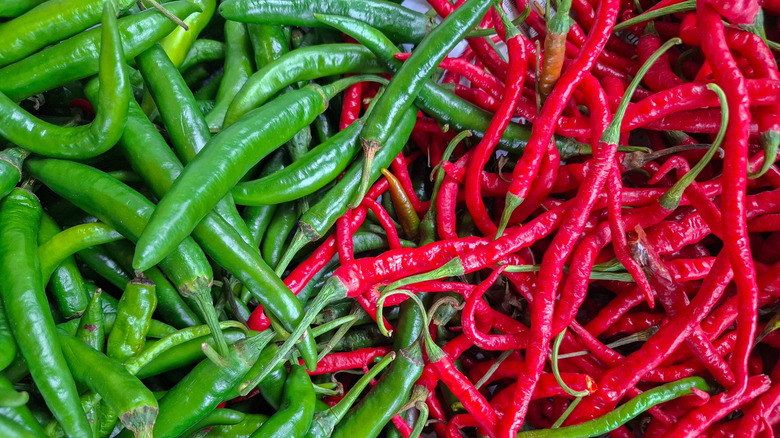Green Vs Red Chili: Here's How The Spicy Dishes Are Different
There aren't many rules when it comes to chili. The comforting stew can include the best chili beans or no beans at all; it can be prepared with almost any kind of meat, or made vegan; and it can be paired with cornbread, tortilla chips, or even cinnamon rolls if you're from the Midwest. However, one way to categorize all these wonderfully diverse chilies is by the color of the chile peppers that bring their signature spice. There's a whole world of chile peppers to explore, from the classic jalapeño to the most expensive Mexican chiles, but, generally speaking, the spicy peppers usually come in one of two colors: red or green.
Red chile peppers are typically used in beefy, tomato-rich red chilies like Illinois-style red chilli (that's with two L's) and Texas-style chili con carne. In contrast, green chile peppers are often paired with pork or poultry in herbaceous green chilies like New Mexico chili verde (the terms "chili" and "chile" tend to get mixed up and used interchangeably, but for this article, "chili" is the comforting, meaty, bean-y, spicy stew we all know and love, while "chile" refers to the hot peppers which are used to make chili).
The difference between making chili with green and red chiles
When making chili, the key difference between red and green chiles is that red chile peppers are almost always added to chili in dried or powdered form, while green chiles tend to be incorporated in fresh or roasted form. Red chile peppers and green chile peppers are actually the same fruits, but red chile peppers are fully ripened, while green chile peppers are picked before reaching maturity. Some chile varieties, like Hatch, jalapeño, and serrano, are usually harvested when green, while others, like Chimayó, Calabrian, and cayenne, are picked when they reach a fully ripened red for optimal flavor.
Taste-wise, green chile peppers tend to be more herbal, tangy, and fresh, while red chile peppers are smokier, sweeter, and deeper in flavor — some compare the difference to ripe versus unripe fruit. Red chilies are typically tomato-based and feature warmer, earthier flavors like paprika, molasses, and cinnamon (the best way to warm up a basic bowl of chili). The sharp tang of green chilies, in contrast, works wonderfully with a simple base of onions, garlic, and chicken broth, plus fresh finishing touches like cilantro and lime juice. No matter what color chiles you're using in your chili, consider amping it up with one (or a few) of these unexpected ingredients you should be adding to chili.

